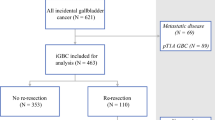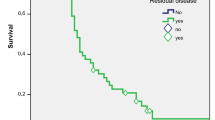Abstract
Background
Better appreciation of the course and factors that influence incidental gallbladder cancer is needed to develop treatment strategies aimed at improved outcomes. The purpose of this study was to determine pattern of disease recurrence and influencing factors in patients undergoing radical re-resection for incidental gallbladder cancer.
Methods
Patients undergoing radical re-resection from February 2003 to May 2010 were analyzed. Influence of variables (lymph node ratio, ASA grade, gender, adjuvant treatment, time interval between cholecystectomy and radical re-resection (in months), and TNM stage) on disease-free survival was assessed.
Results
Of 163 patients, 127 (92 female and 35 male patients; median age 50 years) underwent successful radical re-resection. Median duration between two surgeries was 2 months (range 1–10). Twenty-five percent of patients with pT1b disease had lymph node metastases. Two-year disease-free survival rate was 79.6 % (median follow-up, 16 months). On follow-up, 18 of 24 patients developed recurrences at distant sites. Lymph node metastasis was the single variable significantly influencing disease-free survival. Adjusting for disease stage when analyzing time interval between cholecystectomy and radical re-resection on a continuous scale as a prognostic factor for recurrence revealed no significant impact of increasing interval between surgeries (hazard ratio 1.12; 95 % confidence interval 0.95–1.34; p = 0.17).
Conclusions
The most important predictor of disease recurrence is lymph node metastases. In patients who undergo curative radical re-resection for incidental gallbladder cancer, recurrent disease is more likely to occur at distant sites. Patients with pT1b disease should be offered radical re-resection with a radical lymphadenectomy. It is not the delay in revision surgery but TNM stage that influences outcomes in incidental gallbladder cancer.



Similar content being viewed by others
References
Ferlay J, Shin HR, Bray F et al (2010) Estimates of worldwide burden of cancer in 2008: GLOBOCAN 2008. Int J Cancer 127:2893–2917
Alexander S, Lemmens VE, Houterman S et al (2012) Gallbladder cancer, a vanishing disease? Cancer Causes Control 23:1705–1709
Le MD, Henson D, Young H et al (2011) Is gallbladder cancer decreasing in view of increasing laparoscopic cholecystectomy? Ann Hepatol 10:306–314
Dhir V, Mohandas KM (1999) Epidemiology of digestive tract cancers in India IV. Gall bladder and pancreas. Indian J Gastroenterol 18:24–28
Shrikhande S, Barreto S, Singh S et al (2010) Cholelithiasis in gallbladder cancer: coincidence, cofactor, or cause! Eur J Surg Oncol 36:514–519
Curado M, Edwards B, Shin H et al (2007) Cancer incidence in five continents. IARC Scientific Publications IX, Lyon
Shukla PJ, Neve R, Barreto SG et al (2008) A new scoring system for gallbladder cancer (aiding treatment algorithm): an analysis of 335 patients. Ann Surg Oncol 15:3132–3137
Doval D, Sekhon J, Gupta S et al (2004) A phase II study of gemcitabine and cisplatin in chemotherapy-naive, unresectable gallbladder cancer. Br J Cancer 90:1516–1520
Boutros C, Gary M, Baldwin K et al (2012) Gallbladder cancer: past, present and an uncertain future. Surg Oncol 21:e183–e191
Shrikhande SV, Barreto SG (2009) Surgery for gallbladder cancer: the need to generate greater evidence. World J Gastrointest Surg 1:26–29
Shukla PJ, Barreto SG, Arya S et al (2008) Does PET–CT scan have a role prior to radical re-resection for incidental gallbladder cancer? HPB (Oxford) 10:439–445
Shukla PJ, Barreto SG, Shrikhande SV et al (2007) Detection of gall bladder cancer metastases in rare sites by PET scan. Indian J Gastroenterol 26:303–304
Shukla PJ, Barreto G, Kakade A et al (2008) Revision surgery for incidental gallbladder cancer: factors influencing operability and further evidence for T1b tumours. HPB (Oxford) 10:43–47
Sobin L, Gospodarowicz M, Wittekind C (2009) UICC: TNM classification of malignant tumours. Wiley, Oxford
Horgan AM, Amir E, Walter T et al (2012) Adjuvant therapy in the treatment of biliary tract cancer: a systematic review and meta-analysis. J Clin Oncol 30:1934–1940
Lee SE, Jang JY, Lim CS et al (2011) Systematic review on the surgical treatment for T1 gallbladder cancer. World J Gastroenterol 17:174–180
Ouchi K, Suzuki M, Tominaga T et al (1994) Survival after surgery for cancer of the gallbladder. Br J Surg 81:1655–1657
de Aretxabala X, Roa I, Hepp J et al (2009) Early gallbladder cancer: is further treatment necessary? J Surg Oncol 100:589–593
Shirai Y, Wakai T, Sakata J et al (2012) Regional lymphadenectomy for gallbladder cancer: rational extent, technical details and patient outcomes. World J Gastroenterol 18:2775–2783
Kishi Y, Shimada K, Hata S et al (2012) Definition of T3/4 and regional lymph nodes in gallbladder cancer: which is more valid, the UICC or the Japanese staging system? Ann Surg Oncol 19:3567–3573
Negi S, Singh A, Choudhary A (2011) Lymph nodal involvement as prognostic factor in gallbladder cancer: location, count or ratio? J Gastrointest Surg 15:1017–1025
Shukla PJ, Barreto G, Neve R et al (2007) Can we do better than ‘incidental’ gallbladder cancer? Hepatogastroenterology 54:2184–2185
Glazer E, Liu P, Abdalla E et al (2012) Neither neoadjuvant nor adjuvant therapy increases survival after biliary tract cancer resection with wide negative margins. J Gastrointest Surg 16:1666–1671
Jarnagin WR, Ruo L, Little SA et al (2003) Patterns of initial disease recurrence after resection of gallbladder carcinoma and hilar cholangiocarcinoma: implications for adjuvant therapeutic strategies. Cancer 98:1689–1700
Pasquier E, Kavallaris M, Andre N (2010) Metronomic chemotherapy: new rationale for new directions. Nat Rev Clin Oncol 7:455–465
Acknowledgments
The authors would like to thank Dr. Sudeep Gupta, Professor and Medical Oncologist, Department of Medical Oncology, Tata Memorial Centre for constructive academic inputs.
Conflict of interest
None.
Author information
Authors and Affiliations
Corresponding author
Rights and permissions
About this article
Cite this article
Barreto, S.G., Pawar, S., Shah, S. et al. Patterns of Failure and Determinants of Outcomes Following Radical Re-resection for Incidental Gallbladder Cancer. World J Surg 38, 484–489 (2014). https://doi.org/10.1007/s00268-013-2266-4
Published:
Issue Date:
DOI: https://doi.org/10.1007/s00268-013-2266-4




